Termite and Other Wood-Destroying
Organisms Pest Control 2023
***NOTE -- ![]() To qualify
for continuing education unit credit, you must attend this area
for a minimum of one hour and fifty minutes. Our materials are
timed to take about 2 hours if presented in a live presentation.
Your movement and time spent in the different sections is being
monitored and recorded. *** If you
bookmark or add this page to your favorites, you will not have to re-register if
you get disconnected**(However, remember to remove the bookmark later so you
don't return to outdated material at a later time.) If you do get disconnected, just re-register using MONEY ORDER for the payment method.
To qualify
for continuing education unit credit, you must attend this area
for a minimum of one hour and fifty minutes. Our materials are
timed to take about 2 hours if presented in a live presentation.
Your movement and time spent in the different sections is being
monitored and recorded. *** If you
bookmark or add this page to your favorites, you will not have to re-register if
you get disconnected**(However, remember to remove the bookmark later so you
don't return to outdated material at a later time.) If you do get disconnected, just re-register using MONEY ORDER for the payment method.
- Wood-Boring Beetles
- Formosan Subterranean Termite
- Asian Subterranean Termite
This year's topics include:
WOOD-BORING BEETLES
After wood decaying fungi, termites and, (in some areas of the country), carpenter ants; wood boring beetles cause a considerable amount of damage to our structures.
Wood boring beetles are a large group of organisms that either feed on, tunnel through, or nest within wood. There are a small number of beetles that actually infest living trees. Most beetles function as wood recyclers. Their activities such as boring or burrowing through the wood usually accelerates wood decay fungi. Their frass or wood shavings also accelerates decomposition of wood.
Although there are several species of wood boring beetles, the State of Florida only requires the identification and reporting of beetles which can reinfest seasoned lumber, namely powder post beetles and old house borers.
However, in order to make positive identification of these beetles, you must be aware of several other species with similar sizes and feeding habits.
We're probably fortunate in that damage from these pests usually occurs slowly over a period of years so there is no need to panic the homeowner if they're detected in their structure. In fact, sometimes, when beetle exit holes are detected, the beetles are long gone. Most species do not reinfest seasoned lumber and are simply completing their development within the lumber.
Proper identification of the visible damage, attempting to determine if live larvae are still present, and trying to assess the extent of damage are very important for designing a control program when necessary. Of course, proper, timely identification can save unnecessary treatments.
Some structures will require tent fumigations and other structures might be able to be treated with other alternate methods. Also, if you're an antique collector, you need to make sure you don't bring any of these unwanted pests home with you in the furniture.
REINFESTING BEETLES
Two major groups of beetles reinfest seasoned lumber
within structures. The true powderpost beetles in the family Lyctidae; and the
deathwatch and furniture beetles in the family Anobiidae. A third group, the false
powder post beetles in the family Bostrichidae, can reinfest but rarely do.
Although powderpost beetles is commonly used loosely to refer to all members of the group of beetles that reinfest. However, the term should really be restricted to the Lyctids because they are the only group to produce a true powder.
None of the beetles in the family Cerambycidae reinfest wood with one notable exception, the old house borer. Please refer to the table below for general descriptions and distinguishing characteristics such as type of frass and their exit or entrance holes.
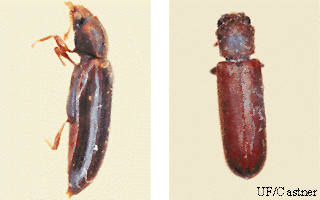 |
| Lyctid beetle |
Lyctid Powderpost Beetles
Lyctids are the most common and widespread of the wood boring beetles that reinfest wood in houses. They can also attack furniture. (However, since our furniture is now stored or used in heated structures whose temperature is unfavorable to the beetles, this damage is becoming less of a problem.)
Lyctids normally overwinter in the larval stage. With the coming of spring, they bore closer to the surface of the wood to pupate. About two to three days after emerging as adults and mating, the females start depositing eggs in the surface pores of wood, particularly the sapwood since it has larger pores than the heartwood of most hardwoods.
The most susceptible woods are oak, hickory and ash although these beetles can also infest walnut, pecan, poplar, sweet-gum and wild cherry. The moisture content of the wood needed for egg laying ranges between 8% and 32% with the greatest activity occurring between 10% and 20%. The moisture content of wood in most residences fall within this range.
Females lay an average of 20 to 50 eggs in exposed areas of the tree or in milled lumber. The hatched larvae bore down the vessels of the wood, making straight tunnels. Later, the tunnels become irregular, intersecting other tunnels. The larvae remain in the wood until the following spring.
Most species complete their life cycle in 9 to 12 months but they can develop more quickly if the temperature and starch content of the wood are favorable. The larvae cannot digest cellulose but they do metabolize the starch within the wood cells. Females taste the wood and do not lay eggs where the starch content is below 3%. She also prefers recently dried wood.
Table 1. Comparison of Lyctid and Ambrosia beetle damage
| Lyctids | Ambrosia | |
| Attacks recently seasoned lumber and wood products; live beetle larvae and adults often found in wood. | Attack dying trees or green, recently felled timber; live beetles never found in seasoned wood. | |
| Damage normally occurs after milling | Damage normally occurs prior to milling | |
| Tunnel walls same color as surrounding wood | Tunnel walls and adjacent areas in wood often stained by fungus | |
| Damage mostly in sapwood of hardwoods | Damage in both sapwood and heartwood |
Kiln drying at the lumber yard retains more starch than air drying. Therefore, air drying wood is less prone to beetle attack and therefore preferable for building. (It is also more expense.) Older wood also has a lower starch content.
It is the female's 'tasting' of the wood that allows a topical, residual chemical to be ingested by the female and establishing control of the infestation.
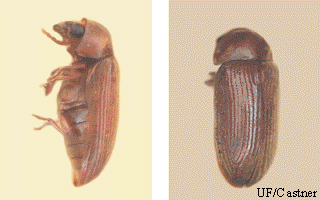 |
| Anobiid beetle |
Anobiid -- Deathwatch and Furniture Beetles
Furniture beetles don't attack furniture nearly as often as their name implies. Deathwatch beetles got their name from the ticking sounds they make late at night which are probably the mating calls of the adults. In older days, family's would hold funeral wakes at their residences. It was customary to have someone with the deceased at all times. While sitting very quietly, in the still of the night and early morning, many people became aware of this ticking sound.
In general, these beetles require a higher moisture content than the lyctids and thus are more frequent pests in coastal areas, unheated dwellings or wherever the humidity is high. Furniture is usually to dry for them to infest.
Some can attack both hardwoods and softwoods and both new and older wood. They feed mainly on the sapwood, digesting the cellulose with the aid of yeast cells in their digestive system. In nature, they live in dead tree limbs or in bark free scars on the tree trunks. In houses, they are more common in the humid crawl spaces.
The females lay their eggs on the surface of the wood in small cracks or crevices. When the larvae hatch, they bore a short distance into the wood, then turn at a right angle and tunnel in the direction of the grain. They make larger and larger tunnels as they grow and pack them with their fecal pellets. Eventually the tunnels become so numerous that they intersect and the wood becomes a mass of fragments.
It may take 2 to 3 years for the larvae to complete their development but during that period they are susceptible to heat and drying that may slow their maturation or even kill them.
When ready to pupate, usually in the spring, the larvae cleans out a portion of the tunnel and enlarges it slightly. The adults bore holes straight out of the wood and seeks a mate, starting the cycle over again. A large portion of the females will lay eggs in the same wood from which they emerged.
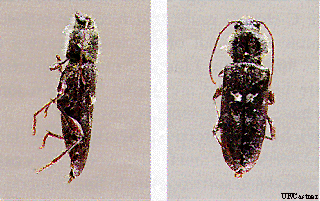 |
Old house borer |
Cerambycid -- Old House Borers
Unlike other cerambycids, the old house borer does not need a bark covering on the wood it attacks. It has been shown to attack lumber in new houses more than in older homes, preferring pine, spruce, hemlock and fir. It cannot develop in lumber from deciduous trees.
The female lays her eggs in cracks and crevices on the surface of the wood and the hatched larvae sometimes crawl around before finding a place through which they can bore into the wood. They remain near the surface, feeding on the sapwood and only gradually penetrating deeper as they grow. Larvae do no attack the heartwood.
The larval period may be completed in 2 to 3 years but it can take as long as 12 or 15 years in very dry wood like in attics. Old house borer tunnels are very distinctive with girdle markings made by the larvae's mouthparts. Unless the moisture content is high, the tunneling proceeds very slowly. Old house borers are able to digest cellulose in their gut without the aid of yeast.
Adults can remain in the tunnels for some time before emerging to mate in the mid or late summer.
NON-REINFESTING BEETLES
These beetles cannot re-infest seasoned wood because they need the bark
layer, or other parts of a tree that are cut away from the wood used to
construct our houses. So, how do they get into our houses? If the
tree is already infested when it goes to the lumber yard, you might have larvae
who have burrowed deep within the tree emerge from the milled lumber into a
house many years after it's been built.
Bostrichid -- False Powder Post Beetles
Members of this group can be pests in furniture. They are the most important pest of hardwoods. Bostrichids do not reinfest seasoned wood. They can attack both hardwood and softwood (including bamboo, wicker and weaving materials of baskets). Very unlikely to be found in baseboards or door moldings.
Females bore into wood and prepare tunnels for laying their eggs. Adult beetles feed on wood as they make the tunnels (usually with the grain) and mating occurs when the tunnel is almost complete. Eggs are laid in pores exposed during the excavation of the tunnels. Larvae normally complete their development in about one year but in drier conditions it could take as long as five.
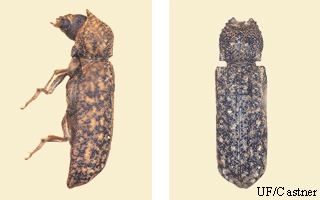 |
Bostrichid Beetle |
Other Wood Boring Beetles
These are usually beetles that attack trees that are usually damage or weakened by disease. When these trees are harvested to be cut into the lumber used to build our homes, some of the beetle larvae will survive the milling process and emerge upon completing their life cycle, especially if the wood is improperly cured.
Beetles of this type are normally flat headed borers in the family Buprestidae or round headed borers in the family Cerambycidae, and bark and timber beetles in the family Scolytidae (known as ambrosia beetles).
These beetles cannot usually reinfest because they require either bark, the cambium layer or living xylem for the placement of eggs. Once these beetles emerge, they perish without laying the eggs that would start a new generation.
Some non-reinfesting beetles may emerge of a period of weeks or months leading to the erroneous conclusion that a new or continued infestation has occurred. The normal method of dealing with these organisms is to simply repair their exit areas (or replacement of the damaged wood).
Table 2. Distinguishing Characteristics of Common Wood Boring Beetles
| Beetle Name | Common Name | Hole size | Frass | Appearance | Reinfest? |
| Lyctus | Powderpost Beetles | 1/32 to 1/16 inch | Fine powder | Galleries are tightly packed with fine powdery frass (flour like) | Yes |
| Anobiid | Furniture or Deathwatch Beetles | 1/16 to 1/8 inch | Pellets | Galleries are loosely packed with fine powder and bun shaped pellets | Yes |
| Bostrichid | False powderpost Beetles | 3/8 to 1/8 inch | Coarse powder | Galleries are packed very tight (the powder will maintain its shape if removed) | Not in seasoned lumber |
| Cerambycid | Old House Borer | 1/4 to 3/8 inch | Pellets | Galleries have ripples (larvae jaw marks) | Yes |
Recognizing Wood Boring Beetle Damage
The only way to really become familiar with damage caused by wood boring beetles is through on the job training and evaluating actual damage. An inspector must look at a variety of factors such as type of wood, what part of wood, gallery or tunneling direction, moisture content, and frass evidence to make a correct and accurate assessment of the problem.
Being able to identify the type of wood is quite difficult for most people who don't spend a lot of time in their favorite lumber yard and/or displaying an appreciation for wood working. Fortunately, we will further restrict our knowledge to seasoned lumber.
The industry is fortunate in that the vast majority of wood normally used in constructing the framing of a house is pine (a softwood). A lot of building codes now require the use of pressure treated lumber in sill plates and other areas of the structure that have historically been subject to moisture damage. This practice has also reduced a lot of beetle infestations as the pressure treating process kills any beetle infestations.
As a side note, there are several methods to pressure treat wood. The most effective is the pressure method and one of the least effective is the hot-cold immersion and cold-soak methods. Dips, sprays and brush methods are probably questionable in their effectiveness. Look for lumber that is treated to the American Wood Preserver's Association's Standard Specification T1-49 which utilizes either full cell or empty cell pressure treatment. This method is also recognized as a standard federal specification TT-W-571.
Hardwoods such as oak is usually used for trim work or finishing work. Some examples would be hardwood floors, stained chair rails and staircase banisters. Furniture and picture framing is normally a higher quality wood product. The other place where hardwood is normally encountered within a structure is the work shop. Be aware that most tools such as, shovels, hoes, brooms, hammers, etc., will have a hardwood handle.
So, if we rely on a table summary, just based on wood types, we can note that:
| Type of Wood | Wood Classification | Suspected Beetle Species |
| Oak, Mahogany, Cherry, Hickory, Ash, Bamboo | Hardwoods | Lyctid (only hardwoods) Anobiid (either, but more common in softwood) Bostrichid (either but preferring hardwood--reinfestation probability low) You can eliminate Cerambycid -- Old house borers. |
| Pine, Spruce, Hemlock, Fir | Softwoods | Anobiid (either, more than likely) Bostrichid (unlikely) Cerambycid -- Old house borer (only softwoods) You can eliminate Lyctids. |
Carrying this thinking to the next level, is the damage occurring with the grain, cross-grain, sapwood or heartwood?
| Sapwood | Grain direction | Suspected Beetle Species |
| Yes | Cross grain | Bostrichid |
| Yes | With grain | Anobiid |
| Yes | Larvae with grain Adults irregular |
Lyctid |
| Yes | With grain (large galleries) girdle marks | Cerambycid |
And lastly, size and fecal material or frass
| Size | Frass | Suspected Beetle Species |
| Small 1/32 to 1/16 inch round holes | Powdery (flour like) tightly packed | Lyctid |
| Small to med 1/16 to 1/8 inch round holes | Powder with bun shaped pellets loosely packed (gritty) | Anobiid |
| Small med to med 1/8 to 3/8 inch round holes | Coarse powdery frass packed very tight (readily maintains shape) | Bostrichid |
| Med to large 3/8 to 1/4 oval shaped holes | Powder with pellets | Cerambycid |
Just to compare with some of our non-reinfesting beetles, Bark beetles will leave scarring directly under the bark. In lower grade lumber sometimes used in attic trusses, you might find a section of board with some small amount of bark still attached. Remove the bark and you might observe bark beetle damage. This damage is very characteristic due to the organism making a large center section and then eating parallel groves perpendicular to the initial center section (resembling a Christmas tree without the taper).
Ambrosia beetle holes will resemble anobiid (the more likely choice as it is normally found in softwoods) or lyctid damage, however, in looking at the lumber you'll notice some of the galleries were cut at various angles during the milling process and you'll also notice a dark staining around the holes and within the galleries.
Buprestid beetle (flatheaded borers) damage will produce large flattened oval holes often 3 to 4 times wider than tall. A lot of their galleries (usually packed extremely tight with frass) will be exposed during the milling process.
There's one more beetle to be aware of belonging to the family Curculionidae (wood boring weevils, snout beetles). Their size will be about 1/8 to 3/16 inch making either a raggedly edged round hole or an irregularly shaped roundish hole. They can attack sap and heartwood of hardwoods, softwoods and plywood. Their frass will consist of very fine powder and tiny pellets packed in wet galleries, similar in appearance to anobiids. These beetles' damage is directly related to the amount of dampness and decay in the lumber. It is not uncommon to notice these beetles in a wet, rotted piece of siding or similar area. No treatment is necessary as they do not reinfest (except within the wood-decay area) and will normally be eliminated upon wood replacement due to the wood decay problem.
Control of Wood Boring Beetles
The prevention and control of these organisms is normally based on the application of insecticides to the wood. Non-chemical controls such as electricity or high and low temperatures have some drawbacks to be aware of.
Prevention is the best control. Here are several tips to practice.
-
Inspect lumber and other wood items before bring them home. Look for small holes and sawdust or tiny wood fragments. Antiques and imported wooden items are particularly vulnerable for this. Small items can probably be heated to solve the problem. Larger items might be required to be taken to a local pest control company to be fumigated in their fumigation vault.
-
Use only seasoned lumber. The drying process kills many types of beetles, including the lyctid or true powderpost beetle.
-
Sealing exposed surfaces. Sanding and coating susceptible woods with varnish, shellac or paint will fill the pores eliminating the habitat necessary for egg laying.
-
Controlling moisture. Good ventilation and proper wood to soil clearance will result in your lumber being drier and thus less favorable for beetle development.
-
Storing firewood away from the house. Infested firewood brought into a house can result in an unwanted infestation. Firewood is best stored outdoors until just prior to it being used. Burning any infested wood will eliminate the infestation. You might also consider de-barking your logs. This eliminates the wood boring beetles that need bark to begin tunneling and egg laying within.
Lyctid, anobiid and related beetles are usually introduced into our structures through building materials. They may have become infested in lumber yard stock piles. They can also enter our homes as larvae or adults in finished wood products such as oak flooring, paneling and furniture. And of course, dead tree limbs may be the source for flying adults entering the structure.
The sapwood of hardwoods is the preferred food source for Lyctid beetle larvae being high in starch. The softwoods (that is wood of conifers such as pine, spruce and fir are sometimes attacked when they are adjacent to hardwoods such as oak and walnut. Oak, ash, and pecan have the largest pores and facilitate egg laying easier.
LIQUID TREATMENTS
The application of liquid pesticides to wood surfaces inside living spaces and in attics and crawl spaces should be performed with care and according to label directions of products with specific directions for controlling these pests. Applicators should wear protective clothing and use a compressed air sprayer to apply the materials to the surface of the wood. Insecticides could also be brushed or painted on. Most labels state to apply to the point of runoff. Care should be taken to not over apply. Research has shown that the best penetration occurs just prior to the point of runoff.
Several products, such as, borates, synthetic pyrethroids and silica aerogels, are available for this purpose. Some of these products come packaged in aerosol cans with injector tips in order to spray within galleries and exit or emergence holes. ALWAYS USE A LOW PRESSURE SPRAY TO REDUCE THE POSSIBILITY OF SPRAY BACK. An applicator should be wearing long sleeve shirt, chemically resistant gloves and full face shield or chemical goggles when making these applications. Although a long residual is a desirable factor in controlling wood boring beetles, you may be restricted to a rapidly degrading product due to a medical condition of one of the occupants.
In addition, be aware that some products will have ODOR PROBLEMS which could exist for several days or even weeks with higher humidity. If this method is used, care should be taken to use as little emulsion as necessary to complete the task.
Also, remember that wood absorbs liquids erratically making the effectiveness unpredictable at times. Wood that has been sprayed with any kind of an oil will be difficult to treat with liquid materials.
ELECTRICAL CURRENT
The use of electricity to control old house borer
larvae in wood has received limited testing for efficacy. Satisfactory results can
be achieved on small pieces of wood within which the location of the infestation is known.
The successful use of this device hinges on the training and expertise of the
device operator.
HEAT TREATMENTS
If the temperature of the wood, in which the
infestation resides, can be raised and maintained at 120 degrees F for at least 30
minutes, the beetles should be killed. One must be cautious as the heat can damage
some items such as furniture by causing it to warp, crack or shrink. This method
is usually impractical for large structures as it's very difficult to maintain the level
of heat within the center of lumber that may be multiple boards stacked or blocked
together (as in some header boards).
FUMIGATION
In a typical application, the entire house is covered
with a large plastic or vinyl tent and a highly toxic gas such as methyl bromide or
sulfuryl fluoride is released throughout the structure. Residents must vacate the
premises for up to three days. The tent confines the fumigant and the entire
structure receives treatment at one time.
Fumigants have no residual value, that is, they do not leave any kind of residue to prevent reinfestations.
Table 3. Summary of Least Toxic Wood Boring Beetle Control Strategies
- Take steps to prevent beetle damage, including making annual inspections for beetles, building with kiln dried or air dried wood, sealing wood surfaces, reducing indoor moisture levels and de-barking and storing firewood away from the house.
- Identify the beetle species causing the damage. If it is a non-reinfesting beetle, there is no need to do anything; if it is a re-infesting variety, follow the procedures below.
- Replace or seal damaged wood.
- Use electricity to kill beetles on a limited spot-treatment basis.
- Use heat treatments to kill beetles within an individual piece of furniture.
- If you must spot treat with chemical controls, use borax based products, pyrethrin/silica aerogel mix, synthetic pyrethroids or chlorpyrifos. Remember that it will take time for the beetles to emerge through or re-enter the treated lumber (Some of the life cycles are two years or more.)
- Tent fumigation is necessary when the infestation is widespread or a quick elimination of the problem is necessary.
Formosan Termites
Coptotermes formosanus Shiraki
HISTORY AND SPREAD
The Formosan subterranean termite is native to China and has been introduced into Japan,
Guam, Sri Lanka, South Africa, Hawaii and the continental United States. It was first
discovered at
a Houston, Texas shipyard in 1965. In 1966, well established colonies of the Formosan
subterranean termite were discovered in New Orleans and Lake Charles, Louisiana and
Houston
and Galveston, Texas. In 1967, the species was found in Charleston, South Carolina.
Well-established colonies were located in Florida in 1980, 1982 and 1984. The Formosan
subterranean termite is extremely destructive, where it has become established.
Most introductions and spread of the Formosan subterranean termite throughout the world
have
probably been from ships. Once introduced, swarming is the termite's natural method of
spread, but
the Formosan termite is a weak flier and does not spread rapidly by itself. The winged
reproductives
are attracted to lights. The movement of infested soil or material such as lumber, wooden
crates or
other wood products is another important method of spread.
In the United States, the Formosan subterranean termite generally has been confined to the southeast at about 32.5 N latitude. This latitude coincides with the warmer temperatures usually associated with this termite. However, the belief that severe winter temperatures limit the spread of these termites may not hold true due to the widespread use of central heating in the U.S. Central heating provides a warm environment, conducive to the survival for termites during winter.
BIOLOGY AND HABITS
Swarming
Termites initiate a new colony by sending out winged reproductives (alates) from an
established
colony. Major swarms of the Formosan subterranean termite begin in May or June until about
July
or August on humid, still evenings between dusk and midnight. Because alates are attracted
to lights,
large numbers can be seen around light sources during a swarm. After a short flight,
alates drop to
the ground, shed their wings and pair off. If they successfully find a small crevice
containing moist
wood, the pair forms a chamber in which the eggs are laid. It usually takes three to five
years to
develop a mature colony. A Formosan subterranean termite queen lays approximately 2000
eggs
per day. A mature colony averages between two and 8.5 million termites and its foraging
territory
may range up to 300 feet from the nest.
Swarming generally starts at dusk; however, the Florida termite, Prorhinotermes simplex,
and
some drywood termite species are also night swarmers. Native subterranean termites
generally
swarm during the day.
Food
Like other termites, Formosan subterranean termites feed on cellulose. They have been
found
attacking 47 species of living plants including citrus, sugar cane, avocado, wild cherry,
cherry laurel,
ligustrum, hackberry, cedar, willow, tallow, wax myrtle, sweet gum, mimosa, cypress, red
bud,
Chinese elm and white oak. Surveys in New Orleans, Louisiana indicated large numbers of
residential and city-owned trees were infested. Formosan termites attacks the bases of
poles, old
tree stumps or other wood in contact with the soil. They have been known to construct galleries to
the upper stories of buildings to feed on wood.
The Formosan termite has been known to attack non-cellulose material such as thin sheets
of
soft metal (lead or copper), asphalt, plaster, mortar, creosote, rubber and plastic in
search of food
and moisture. Their highly publicized ability to chew through concrete is a fallacy,
however, the
Formosan subterranean termite is uncanny in finding small cracks in concrete which they
use as
foraging routes.
A single Formosan subterranean termite does not consume more wood than does the native
subterranean termites. The rapidity of damage is related to the termite's high
reproductive capacity
and large colony size.
Nests
Formosan termite nests are made of carton which consists of chewed wood, saliva and
excrement. Nests can be constructed in the ground or aerially. Formosan subterranean
termites can
produce massive carton nests. The native subterranean termite also produces carton when
nesting,
but it is small when compared with the Formosan subterranean termite nest. Auxiliary nests
are often
constructed in the walls of buildings or in the food source. When a nest or gallery is
disturbed, the
Formosan termite soldiers are usually present in larger numbers and are more aggressive
than the
native termites.
Damage
Most subterranean termites feed along the grain of the wood, eating the spring wood and
leaving the summer wood. The Formosan termite feeds on both and forms a hollow. If the
hollow is
large (tree or timber), it is then filled with carton material to form a nest. Formosan
termites, like our
native subterranean termite, construct tunnels (foraging galleries) from the nest to
infest wood. In
Hawaii, where unprotected homes were built over large colonies, records show that the
Formosan
subterranean termite caused major structural damage in six months and almost complete
destruction
in two years.
Moisture Requirements
The Formosan termite, like all subterranean termites, uses the soil for a source of
moisture.
However, Formosan termite colonies can obtain moisture from plumbing or roofing leaks.
RECOGNITION
Termites are social insects and three forms (called castes) are commonly seen: winged reproductives (alates), soldiers and workers. The nests are also characteristic and easily identifiable as Formosan.
Workers and Nymphs
The workers and nymphs of the Formosan termite are white. They are difficult to
distinguish
from other termite species.
Soldiers
The Formosan termite soldier have an orange-brown, oval or egg-shaped head,
which is shorter than the heads of native termites with curved mandibles and a
whitish body.
When an infested timber is examined, soldiers are more abundant than with our native termites. There are more soldiers (10 to 15%) in a Formosan colony than that of the native subterranean species in Florida (1 to 2%). Because the colony contains a larger soldier proportion than native subterranean termites, infestations with many soldiers is a clue to its presence.
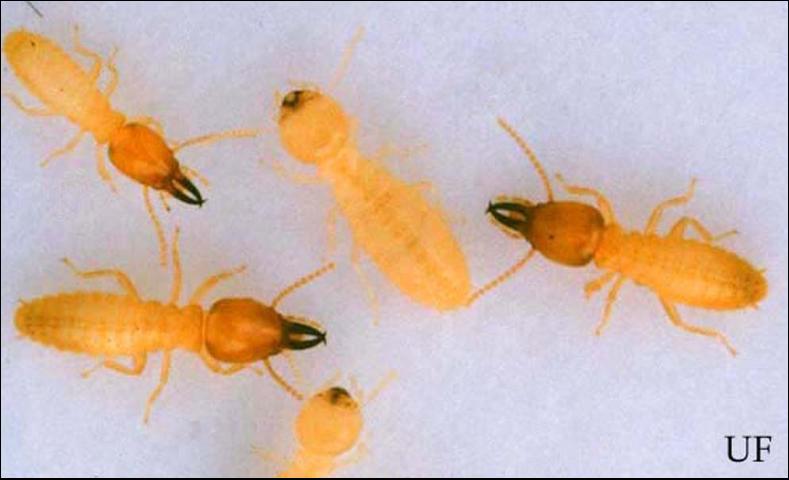
The soldiers are more aggressive and will attack anything used to probe the damage. When disturbed, the soldiers exude a white gluey fluid or substance (defensive secretion) from a large opening (the fontanelle), located on the top, front of the head. In native termites, the fontanelle is small and barely visible.
Winged Reproductives
The winged reproductives of the Formosan termite are yellowish-brown and are 12-15 mm
long (0.5-0.6 inches). Native subterranean termites are 10 mm long (0.4 inches).
Reticulitermes
virginicus and R. flavipes have black bodies, while R. hageni is about the same color as
the
Formosan termite. The ocelli of the Formosan termite are large, whereas they are small on
native
termites.
The winged forms look very much like drywood termite reproductives in size and color. It
is
important to look at the head or wings with a microscope to tell the difference
positively. Otherwise,
it is necessary to find soldiers or damage.
The wings of the Formosan termite are 10 mm in length and have two heavily pigmented veins
near the front edge of the wing. The median vein is present and may or may not be
branched.
Formosan subterranean termite wings are hairy when compared with the nearly bare wings of
the
native subterranean termite when observed under low magnification.
WHERE TO LOOK FOR FORMOSAN TERMITES
All types of structures, piers, pilings, posts, logs, utility poles and
timber in contact with soil
should be carefully inspected.
Formosan termites generally invade structures from the ground. They commonly enter though
expansion joints, cracks, and utility conduits in slabs, and holes for tub drains. Any
wood connecting
with the ground is an inviting entrance to these termites. Foraging galleries lined with
carton material
are then constructed to the food source.
The Formosan subterranean termite does not always require ground connection. If a pair of
alates successfully finds adequate food and moisture sources in a building, it can
initiate a colony with
no ground connection. The flat roofs of high rise buildings are places for the Formosan
subterranean
termite to initiate aerial infestations if portals of entry are found because they almost
always contain
water. Survey data indicate that more than 25% of the infestations found in urban
southeastern
Florida are caused by aerial colonies.
WHAT TO LOOK FOR
Watch for flights of reproductives in the spring and fall. Special attention should be given to picture windows, light fixtures and other well lighted areas. These termites swarm at night and are attracted to lights in large numbers. Cobwebs, window sills and other areas that collect debris should be inspected for wings of termites.
Another characteristic of Formosan Subterranean Termite is carton nest material that is made of termite excrements, chewed wood, and soil. Carton nests are usually found in structure voids such as between walls and beneath sinks.
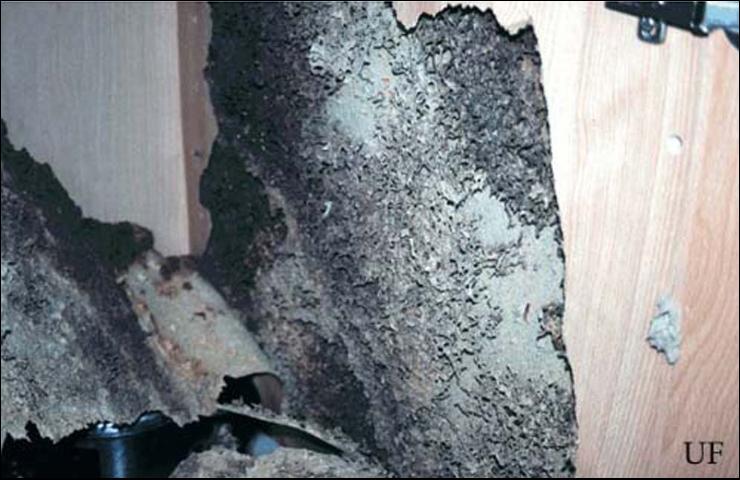
Inspect the inside and outside of structures for tunneling. Look for tunnels that
disappear in
cracks of masonry, in and around doors and window frames and along siding. A hollow sound
in
walls, baseboards and floors suggests infestation. Check for tunnels and other evidence of
infestation
in crawl spaces under structures.
Tunnels may not be evident in wood or wood products. It is best to probe such samples for
evidence of infestation.
INSPECTION OF CONCRETE SLAB CONSTRUCTION
Inspect for evidence of termite activity near any plumbing that goes through the slab. Look for tubes around baseboards. Tap baseboards around walls. Check for wood which is in contact with the soil.
IDENTIFICATION OF SPECIMENS
Collect evidence of infestation and save soldiers or winged reproductives. Examine the specimens closely or send suspect samples to your County Cooperative Service Extension Office. Preserve all specimens in 70% rubbing alcohol. Submit at least ten (10) specimens if available.
PROCEDURES FOR IDENTIFICATION
1.To identify the winged reproductive, make sure the wing is completely flattened. Often
wings
have a tendency to curl along the front edge, and the wing may appear to have one or two
veins rather than two or three.
2.Place the wing on a white background to obtain a true wing color.
3.Observe the type of damage.
4.Observe how wet or dry the wood is near the area of termite damage.
5.Note the time of year and time of day swarming took place.
CONTROL OF FORMOSAN TERMITE
Preventive Control
The best control of the Formosan termite is prevention. Too much emphasis cannot be placed
on the fact that the best time to provide protection against termites is during the
planning and
construction of the building.
1.Pretreat soil with recommended insecticides under and around the perimeter of the slab.
2.Make thorough annual inspections for evidence of termite activity.
Remedial Treatment
The basis for control of subterranean termites (the Formosan is a subterranean termite) in
buildings is to chemically treat the soil (at normal treatment rates) so that termites die
as they move between the colony and wood.
If a termite-proof chemical barrier is established between the soil and
wood, the termites in the house cannot gain access to the soil to get moisture. If there
is no moisture in the house, the termites will die. Also termites in the soil cannot gain
access to the wood in the house.
Spot treatment of sections of a building may not prevent the termite from gaining access
elsewhere. The Formosan termite constructs galleries that may cover up to one acre of
land, and it
can easily find untreated areas to enter the building.
Every effort should be made to complete the chemical barrier under the
building to prevent future entry. Control is possible if the pest control operator and the
public are aware that greater care is required when treating infestations. The Formosan
termite takes advantage of a pesticide applicator's mistakes and is likely to require
retreatment more often than native termites.
Buildings should be thoroughly inspected to discover and eliminate all sources of
moisture. The
Formosan termite builds auxiliary nests in the walls of buildings and is able to survive
for months
without soil contact. Therefore nests should be located and a chemical treatment applied
to destroy
the nests.
Home owners should consult a reputable, experienced, certified pest control operator
rather
than attempt home remedies to control this serious pest.
Bait Systems
Development of subterranean termite baiting systems offers another alternative to Formosan
termite control. These systems establish monitoring stations around the perimeter of
the structure. The system must be monitored frequently during its initial
installation to check for feeding or foraging from subterranean termites. It might
take several months for the termites to 'discover' the feeding stations.
During this time, particularly if there is an active infestation in the structure, a spot or localized chemical treatment might be a prudent measure to reduce termite damage while waiting for the monitoring stations to become active feeding stations.
Upon discovery of feeding evidence, a toxicant is placed within the station that the termites will then distribute within the colony. Most labels require additional stations to be installed within close proximity of the active station in an attempt to establish additional feeding which will move more of the toxicant into the colony in a shorter period of time.
The toxicants will then reduce the colony's population to a level that will normally result in its collapse as there will not be enough workers to keep up with the housekeeping chores and naturally occurring molds, fungi and disease which will most likely finish the elimination of the rest of the colony.
Fumigation
Generally fumigation is not recommended to control Formosan termites. It may be necessary
to
apply a fumigant gas to kill auxiliary nests in special cases where the soil has been
properly treated
and the infestation continues from an unknown moisture source. If a house is fumigated and
the soil is
not treated, there is nothing to prevent reentry of termites from the soil.
Treatment of Infested Trees
Surface applications of chemicals to trees will not control Formosan termites, which will
usually hollow out the center of trees. Formosan termites can be controlled in living
trees by drilling holes above the soil line and injecting the chemical into the void
created by the termites or by the use of baiting systems established in close proximity to
the infested tree.
Dr. Chouvenc has been doing research into loss of tree canopy (which is shown to be substantial) and is working on a baiting system to treat infected trees. Treating trees is proving to be very important to reduce the termite pressure in the environment surrounding our structures, let alone the environmental impact of losing valuable resources. The last discussion we heard at a PCEAC meeting was that this should be released for marketing within a year.
Asian Subterranean Termite
Coptotermes gestroi (=havilandi) (Wasmann)
Introduction
Kirton and Brown (2003) determined that "Haviland's subterranean termite," Coptotermes havilandi Holmgren, was a newer second name given to a termite that already had the name Coptotermes gestroi (Wasmann). By proper taxonomic convention, the older name, C. gestroi, must be recognized. They also proposed that C. gestroi be given the common name of "Asian subterranean termite." Coptotermes gestroi is a very damaging termite and a threat to wooden structures wherever it occurs. As one might expect, C. gestroi is similar in many respects to C. formosanus Shiraki, the Formosan subterranean termite. General information related to the life history, damage, and management of C. formosanus is applicable to C. gestroi. This report highlights the known distribution and important distinguishing characteristics of C. gestroi.
Distribution
Coptotermes gestroi is endemic to Southeast Asia. Over the last century, human activity has spread this termite species far beyond its native range. It was collected in the Marquesas Islands (Pacific Ocean) in 1932, and Mauritius and Reunion (Indian Ocean) in 1936 and 1957, respectively. In the New World tropics, this species was first reported in Brazil in 1923 and in Barbados in 1937. Recent collections from other West Indian islands include Antigua, Barbuda, Cuba, Grand Cayman, Grand Turk, Jamaica (Montego Bay and Port Antonio), Little Cayman, Montserrat, Nevis, Providenciales, Puerto Rico (San Juan), St. Kitts, and on a boat from the US Virgin Islands. It has also been collected in southern Mexico.
In 1996, C. gestroi was collected for the first time in the continental United States from a storefront and a church in Miami, Florida (Su et al. 1997). In 1999, a colony of C. gestroi was discovered infesting a waterfront house in Key West, Florida. In 2001 a single alate was collected in Lauderhill, Broward County, Florida. As of 2004, six structures in Key West have been verifiably infested with C. gestroi. A boat moored off Fleming Key and in drydock on Stock Island (east of Key West) was also infested. Broward and Dade are the only known counties where C. formosanus and C. gestroi have both become established. Elsewhere in the world, these two widely introduced species are geographically isolated. Coptotermes formosanus usually invades mildly temperate climates (to 35 degrees north latitude in the US), while C. gestroi is limited to more tropical localities (to 26 degrees north) as noted above. In the West Indies, C. gestroi has invaded some natural woodland habitats. In Florida, it has been collected only from structures, ornamental trees near structures, and boats. Three private boats in Florida have been found with shipboard infestations, one arriving from Jamaica, one from Virgin Gorda, and one from Providenciales. These boats were docked in Ft. Pierce, Hollywood, and Ft. Lauderdale, respectively. Shipboard infestations are the most likely means of human dispersal of this pest as the result of on-board dispersal flights that reach land.
In early 2005, C. gestroi was found in the cities of Ft. Lauderdale and Riviera Beach (adjacent to the north of West Palm Beach). These discoveries are new records for established, land-based colonies of this species in Palm Beach and Broward Counties. The Riviera Beach infestations mark a substantial northward range expansion for this species in Florida and are the northernmost established colonies of this tropical species worldwide. The presence of mature C. gestroi colonies in these areas significantly increases the overlap in south Florida between this tropical termite and the closely related Formosan subterranean termite, C. formosanus, a more temperate species. Currently, this is the only known location in the world where the two species occur together (sympatry).
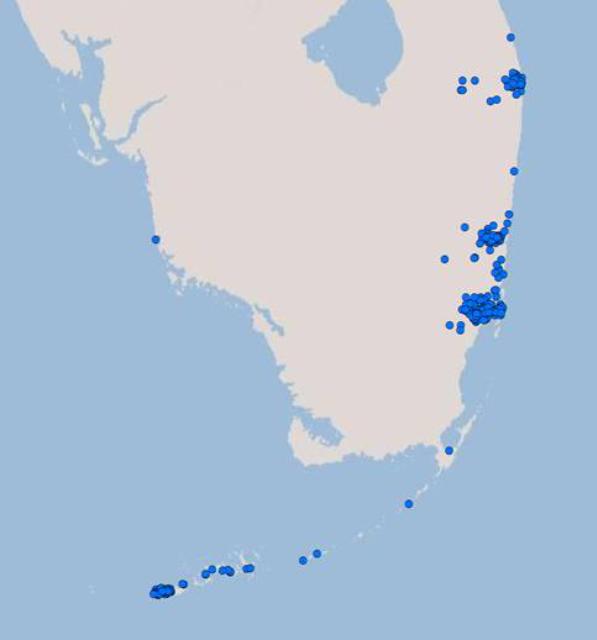
Figure 1. Asian Subterranean Termite, Coptotermes gestroi, distribution map.
Description and Identification
Superficially, soldiers of C. gestroi resemble those of C. formosanus. Both species have a large opening on the forehead called the fontanelle. When viewed from above, both also share tear drop-shaped heads. Microscopic examination of the fine hairs on the head reveals diagnostic differences. Coptotermes gestroi soldiers have one pair of hairs near the rim of the fontanelle, while in C. formosanus, two pairs originate around the fontanelle. Additionally, the lateral profile of the top of the head just behind the fontanelle shows a weak bulge in C. gestroi that is absent in C. formosanus. As with C. formosanus, C. gestroi soldiers constitute about 10 to 15 percent of foraging groups, aggressively bite when challenged, and exude a white mucous-like secretion from the fontanelle.
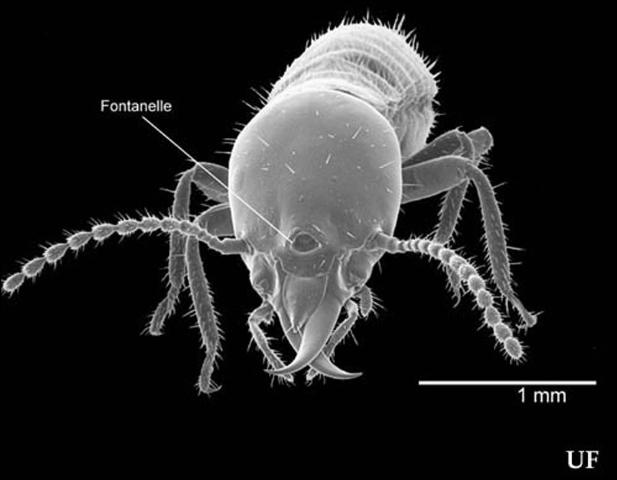
Figure 2. Formosan subterranean termite, Coptotermes formosanus Shiraki, soldier showing the ovoid head shape and large fontanelle that are characteristic of all Coptotermes species.
Credit: Rudolf H. Scheffrahn, University of Florida
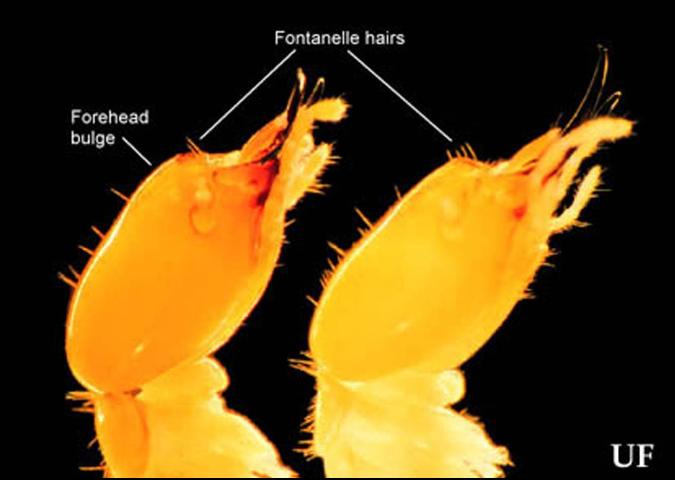
Figure 3. Lateral view of soldier head capsules of Coptotermes gestroi (Wasmann) (left) and C. formosanus Shiraki. Antennae removed for clarity.
Credit:
Rudolf H. Scheffrahn, University of Florida
The alates of C. gestroi are slightly smaller than those of C. formosanus (total length with wings about 13–14 mm vs.14–15 mm, and maximum head width 1.4 mm vs. 1.5 mm, respectively). The head, pronotum, and dorsal abdomen of C. gestroi alates are dark brown, while those of C. formosanus are entirely a lighter yellow-brown or orange-brown. The darker pigmentation of the C. gestroi head provides a contrasting background for two light patches on the face called antennal spots. In C. formosanus the antennal spots are barely, if at all, visible. The length of wing hairs is somewhat shorter in C. gestroi than in C. formosanus.
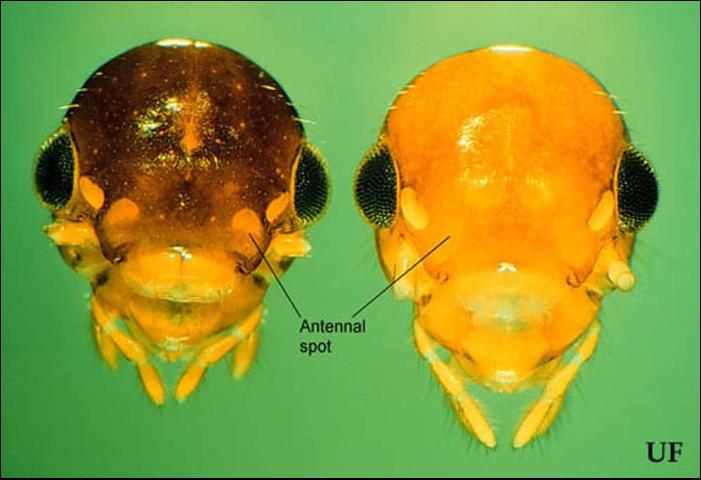
Figure 4. Alate head capsules of Coptotermes gestroi (Wasmann) (left) and C. formosanus Shiraki. Antennae partially removed for clarity.
Credit: Rudolf H. Scheffrahn, University of Florida
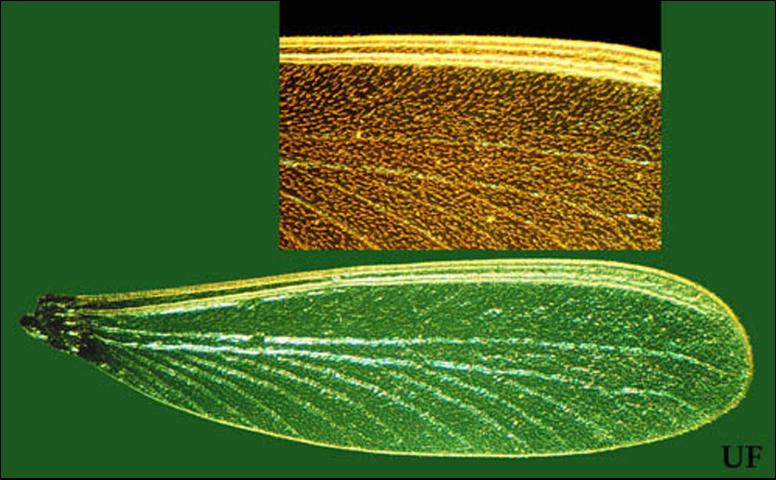
Figure 5. Coptotermes gestroi (Wasmann) wing (inset shows close-up of hairs on wing membrane).
Credit: Rudolf H. Scheffrahn, University of Florida
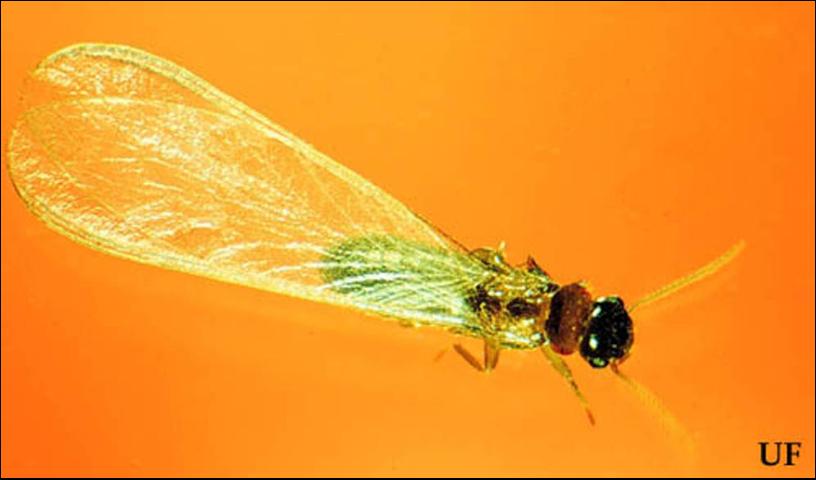
Figure 6. Coptotermes gestroi (Wasmann) alate.
Credit: Rudolf H. Scheffrahn, University of Florida
Life History
Like C. formosanus, C. gestroi dispersal flights or "swarms" occur at dusk or at night in which large numbers of alates leave the colony. A flight of C. gestroi occurred in a Key West hotel room on 10 February 2004 at 1:30 a.m. The hotel occupants reported that they and their belongings were covered with alates and many had crawled into their luggage and clothing. In Florida and the West Indies, C. gestroi flights have been record between February and April. The C. gestroi flight season ends about when the C. formosanus flight-season begins. Porch lights, indoor lights, and video monitors often attract the alates inside, especially when doors and unscreened windows are opened. When large numbers (100s–1,000s) of alates are found indoors, their presence is usually indicative of a structural infestation as noted above. Alates flying indoors are unlikely to find the moist wood/soil substrate they need for successful colonization, and succumb quickly to desiccation. It is likely, however, that most dispersal flights will produce a few new colonies that may become a damage threat in future years.
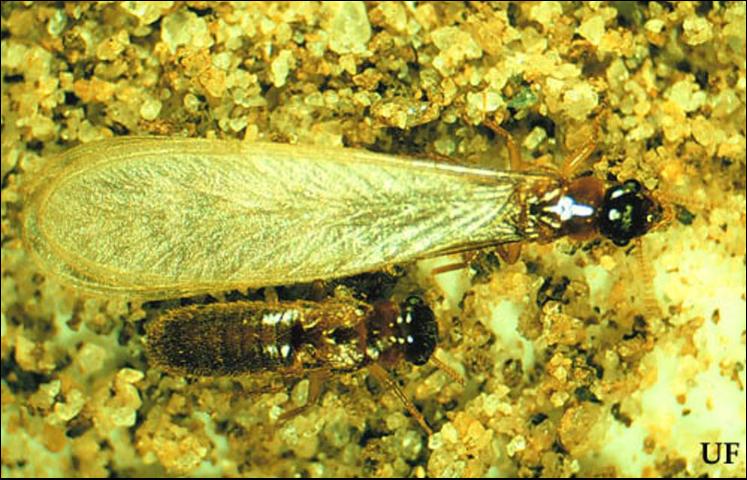
Figure 7.Coptotermes gestroi (Wasmann) alate (top) and dealate.
Credit: Rudolf H. Scheffrahn, University of Florida
Damage
Like other structure-infesting species of Coptotermes, damage resulting from a C. gestroi infestation can become severe in a relatively short time, especially when a structure is invaded by a large, mature colony. Dispersal flights, foraging tubes, or damage are usually the first indications of an infestation. Advanced stages of infestation are indicated by the incorporation of nest material (carton) in hollowed wood or existing structural voids.
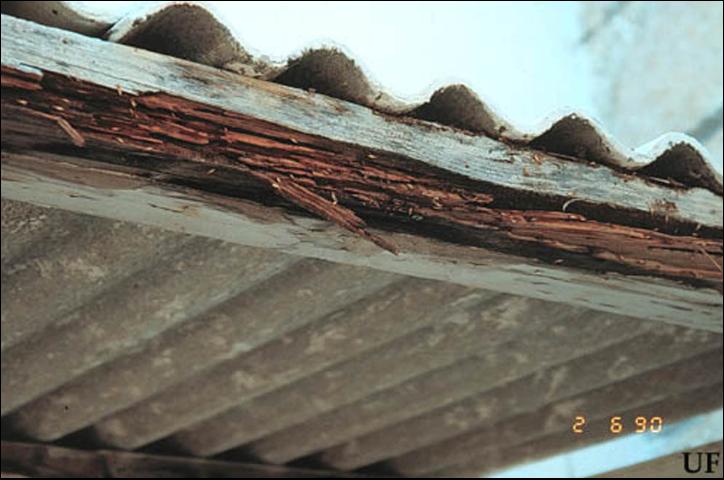
Figure 8. Damage by Coptotermes gestroi (Wasmann) to fascia, Grand Turk Island.
Credit: Rudolf H. Scheffrahn, University of Florida
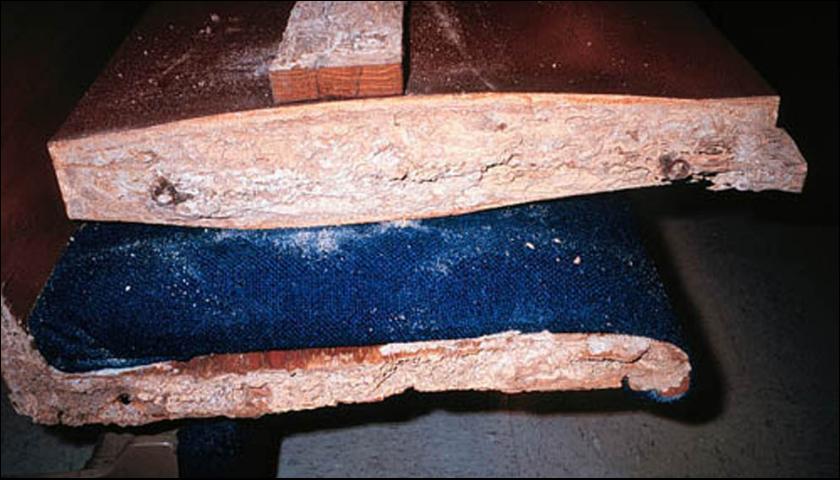
Figure 9. Damage by Coptotermes gestroi (Wasmann) to church pew, Miami.
Credit: B. Maharajh
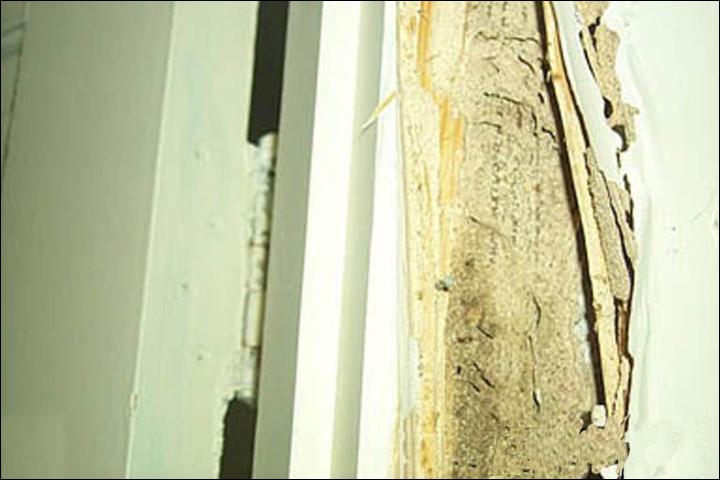
Figure 10. Carton material in door casing damaged by Coptotermes gestroi (Wasmann), Key West.
Credit: Mark Lang

Figure 11. Foraging tube made with coral sand by Coptotermes gestroi (Wasmann), Key West.
Credit: Mark Lang
Pest Status
Infestations of C. gestroi in Florida are becoming more common in recent years and will continue. Due to climatic restrictions, the future distribution of C. gestroi in the continental United States will probably not extend far beyond southern Florida. The importance of this pest is likely to increase in the West Indies and it may surface in other tropical regions in years to come.
Management
The same management strategies such as baits and soil treatments employed for C. formosanus should be considered for C. gestroi.
References
Wood-Destroying Insects, SP 193, P.G. Koehler, J.L. Castner, Department of Entomology and Nematology, Florida Cooperative Extension Service, Institute of Food and Agricultural Sciences, University of Florida, First published January 1996, Reviewed June 2008, EDIS website: http://edis.ifas.ufl.edu.
Powderpost Beetles and Other Wood-Infesting Insects, ENY-266, P.G. Koehler, F.M. Oi, Department of Entomology and Nematology, Florida Cooperative Extension Service, Institute of Food and Agricultural Sciences, University of Florida, First published March 1994, Revised January 2003, EDIS website: http://edis.ifas.ufl.edu.
Southern Lyctus Beetle, EENY-283, Angela S. Brammer, Department of Entomology and Nematology, Florida Cooperative Extension Service, Institute of Food and Agricultural Sciences, University of Florida, First published March 2003, Reviewed March 2008, EDIS website: http://edis.ifas.ufl.edu.
The termite information comes from the EDIS website at http://edis.ifas.ufl.edu. EDIS houses a series of documents from the Featured Creatures project as well as other entomological publications from the Entomology and Nematology Department, Florida Cooperative Extension Service, Institute of Food and Agricultural Sciences, University of Florida.
The various authors associated with the documents used are: Thomas Chouvenc, Rudolf H. Scheffrahn, Nan-Yao Su, Brian Cabrera and William Kern, Jr., Entomology and Nematology Department, Institute of Food and Agricultural Sciences, University of Florida, Ft. Lauderdale, FL.
The Institute of Food and Agricultural Sciences (IFAS) is an Equal Opportunity Institution authorized to provide research, educational information and other services only to individuals and institutions that function with non-discrimination with respect to race, creed, color, religion, age, disability, sex, sexual orientation, marital status, national origin, political opinions or affiliations. For more information on obtaining other extension publications, contact your county Cooperative Extension service.
